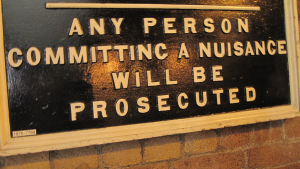Clarity Law

Lucy Ferguson
Essential Guide to Public Nuisance
Section 6 of the Summary Offences Act 2005 makes out the offence of public nuisance. It is considered a relatively minor charge that can be dealt with by way of an infringement notice or through prosecution in Court. This guide seeks to give you an overview of the offence of public nuisance and the penalties the court may impose. This guide is in relation to Queensland law only.
What is a Public Nuisance?
A person commits a public nuisance offence if they act in a manner that is considered disorderly, offensive, threatening, or violent and their behaviour interferes with, or is likely to interfere with, the peaceful passage or enjoyment of a public place.
Disorderly Behaviour
In order for conduct to be considered disorderly it must be met with the disapproval of the well conducted and reasonable person and annoy or insult such a person in such a way that it is serious enough to warrant the interference of the law.
What is considered disorderly behaviour can vary depending on the time and place of the conduct.
Offensive Behaviour
A person has acted in an offensive way if they have used offensive, obscene, indecent or abusive language. This test is not a question of if a person felt abused or offended but rather if the words used were objectively offensive.
Threatening or Violent Behaviour
In order for behaviour to be considered threatening the language used must include a threat to cause injury that is intended to be taken seriously.
A person has acted violently if they have used actual force against a person or property
Passage or Enjoyment of a Public Place
For the offence of public nuisance to be made out it is not required that the person charged be in a public place but rather that their actions interfere with a member of the public’s passage or enjoyment of a public place.
This means that being on your own property and yelling offensive language at someone on the road is sufficient to make out the charge.
Going to Court
Generally most court matters follow this procedure;
- The court will generally start at 9:00am
- From just after 8:30am there will be a police prosecutor in the court room giving people their QP9 (what is a QP9 see our article here) and asking people if they are pleading guilty, not guilty or seeking an adjournment
- Once the court starts your name will be called at some point
- The court will then ask you if you are pleading guilty, not guilty or seeking an adjournment.
- If you are seeking an adjournment then the court is quite willing to grant an adjournment on the first occasion the matter is heard in court. If you seek further adjournments the court will need to be convinced you have a valid reason.
- If you are pleading guilty then the guilty plea can usually be conducted there and then. The police prosecutor will provide the court with a verbal overview of what occurred and then tender your criminal and traffic history (if you have any). You can then address the court on what occurred and the penalty to be imposed. The types of things that the court might be interested in hearing from you in regards to the penalty included.
- Why the offence occurred
- What you do for living
- How much money you make a week
- Addressing any similar charges you have previously committed
Penalties for Public Nuisance
There are two options available to police officers that believe you have committed the offence of public nuisance. The first option is that they can give you an infringement notice or ticket and the second is that they can issue you with a notice to appear in court.
The maximum penalty for Public Nuisance is 10 penalty units or 6 months imprisonment, however this is increased to 25 penalty units or 6 months imprisonment. At the time of writing this (March 2022) a penalty unity is $137.00.
If the police have issued you an infringement notice or ticket the ticket will be for a different amount based on the type of behaviour and location of the offence.
|
Behaviour |
Location |
Penalty |
|
Abusive, indecent, obscene, or offensive language |
Public place but not within the vicinity of a licensed premise |
1 penalty unit |
|
Abusive, indecent, obscene, or offensive language |
Public place within the vicinity of a licensed premise |
3 penalty units |
|
Disorderly, offensive, threatening, or violent behaviour |
Public place but not within the vicinity of a licensed premise |
3 penalty units |
|
Disorderly, offensive, threatening, or violent behaviour |
Public place but not within the vicinity of a licensed premise |
6 penalty units |
Quick Guide to Community Service Orders
A Community Service Order or CSO is one of the options open to Queensland courts when sentencing an individual. A Community Service Order requires an individual to complete unpaid community service under the supervision of a corrective services officer for a set number of hours determined by the court. The order can only be made with the consent of the individual being sentenced.







